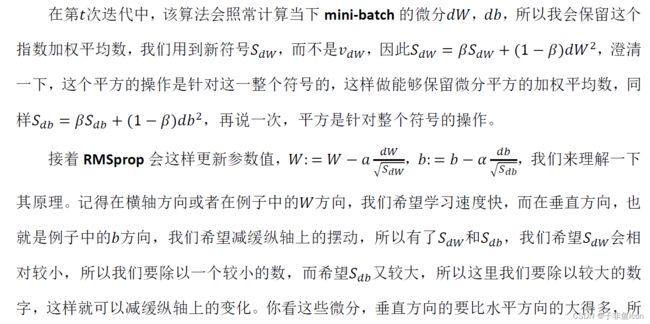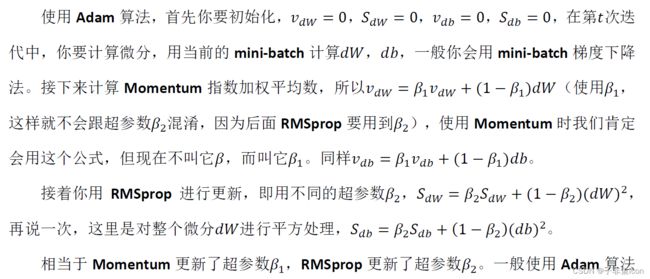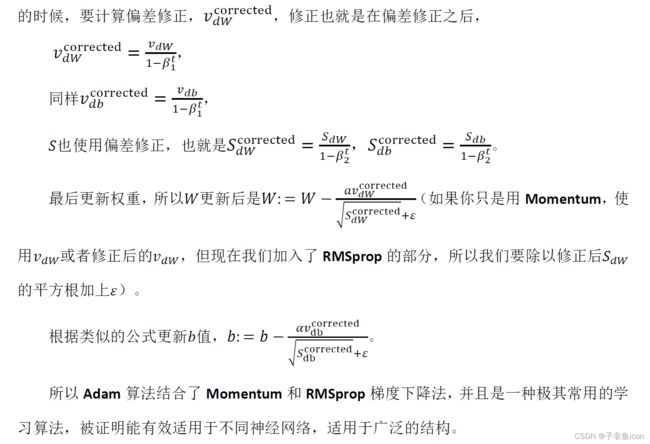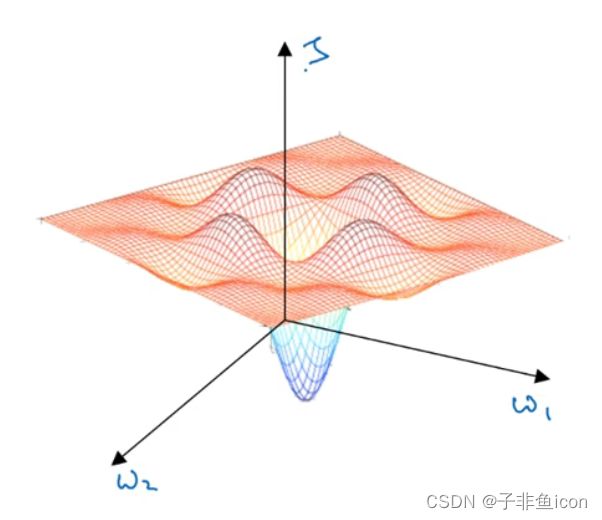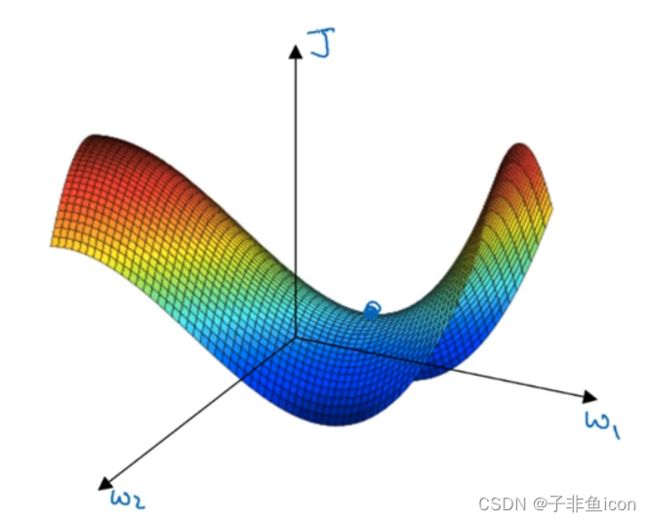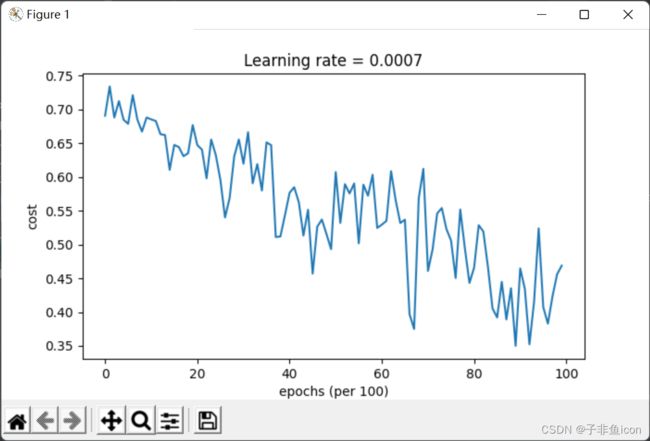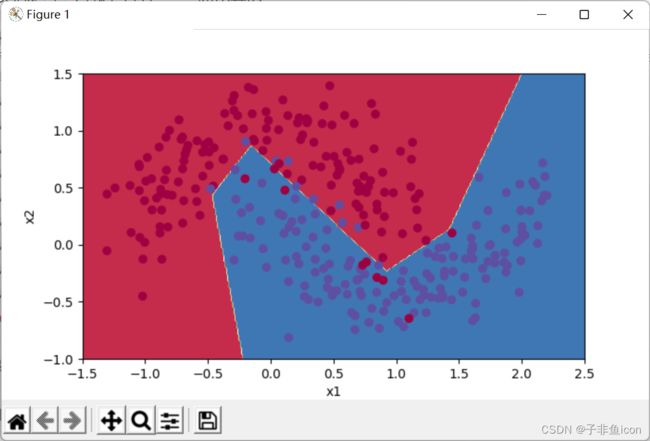吴恩达深度学习笔记(五)——优化算法
一、mini_batch梯度下降法
如果使用batch梯度下降法,mini-batch的大小为m,每个迭代需要处理大量的训练样本,弊端在于巡林样本巨大的时候,单次迭代耗时过长。
如果使用随机梯度下降法(mini-batch为1),只处理一个样本,通过减小学习率,噪声得到改善或者减小。缺点是失去向量化带来的加速,效率低下。且永远不会收敛,会一直在最小值附近波动,并不会达到最小值并停留在此。
所以实践中,通常选择不大不小的mini-batch尺寸。一方面,得到了大量向量化,比一次性处理多个样本快得多。另一方面,不需要等待整个训练集被处理完就可以开始后续工作。mini-batch梯度下降法不会总朝向最小值靠近,但比随机梯度下降更持续的靠近最小值的方向,也不一定在很小的范围内收敛或波动,如果出现这个问题,可以慢慢减少学习率。
mini-batch的选取指导原则:
如果训练集较小,直接使用batch梯度下降法,比如少于2000个样本;
样本数目较大的话,一般的mini-batch大小设置为64到512。考虑到电脑内存设置和使用的方式,mini-batch大小为2的n次方,代码运行的会快一些。
二、指数加权平均数
指数加权移动平均(Exponentially Weighted Moving Average),他是一种常用的序列处理方式。在 t t t时刻,他的移动平均值公式是: V t = β V t − 1 + ( 1 − β ) θ t V_{t}=\beta V_{t-1}+(1-\beta) \theta_{t} Vt=βVt−1+(1−β)θt , t = 1 , 2 , 3 , . . . n t=1,2,3,...n t=1,2,3,...n ,其中 V t V_{t} Vt是 t t t时刻的移动平均预测值; θ t \theta_{t} θt为 t t t时刻的真实值; β \beta β是权重;
以下该链接有β与平均多少天之间的关系:
参考链接
偏差修正:
在估测初期,不用 v t v_{t} vt,而是用 v t 1 − β t \frac{v_{t}}{1-\beta _{t}} 1−βtvt
但在机器学习中,大部分时候并不在乎执行偏差修正,熬过初始时期,继续计算。
三、动量梯度下降法(momentum)
对于梯度下降法,很可能会出现上图那样的情况,需要很多的计算步骤。这种上下的波动会减慢梯度下降法的速度,无法使用更大的学习率(否则摆动较大,紫色箭头),就只能使用较小的学习率。但从横轴来说,希望加快学习,能够快速从左到右,移动到最小值。
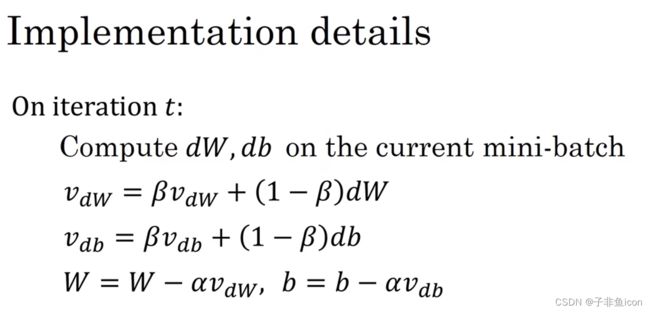
注:
1. β \beta β最常用的值是0.9,是很棒的鲁棒数。
2.关于偏差校正,一般也不会进行。因为10次迭代后,移动平均已经过了初始阶段。
3. v d w v_{dw} vdw是维数和 d w dw dw, w相同的零矩阵。
4.有的资料会把后面的项 1 − β 1-\beta 1−β删除,这导致的结果是:学习率 α \alpha α要根据 1 1 − β \frac{1}{1-\beta} 1−β1相应变化。
四、RMSprop
RMSprop也可以加速梯度下降。
假设纵轴是b,横轴是W,虽然横轴方向在缓慢推进,但纵轴方向会有大幅度地摆动。RMSprop就能减缓b方向的学习,加快横轴的学习。
简单解释一下就是:db大,所以算得的Sab也大,b的更新式除以了一个较大的数,所以减缓了b的摆动。蓝色的前进曲线被压缩为绿色的:

注:如果 S d w S_{dw} Sdw的平方根趋近于0,要确保算法不会除以0,所以就要在分母上加上一个很小很小的数 ϵ \epsilon ϵ,比如 1 0 − 8 10^{-8} 10−8,保证数值稳定。
五、Adam优化算法
结合了Momentum和RMSprop
β 1 \beta _{1} β1:0.9
β 2 \beta _{2} β2:0.999
ϵ \epsilon ϵ: 1 0 − 8 10^{-8} 10−8
六、学习率衰减
加快学习算法的一个办法就是:随时间慢慢减少学习率。
蓝色线:使用mini-batch梯度下降法,在迭代过程中,存在着噪音,下降朝向最小值,但不会精确收敛,在附近摆动。这是因为用的 α \alpha α是固定值。
绿色线:但如果随着 α \alpha α变小,步伐也会变小,最后曲线会在最小值附近很小的一块区域内摆动。
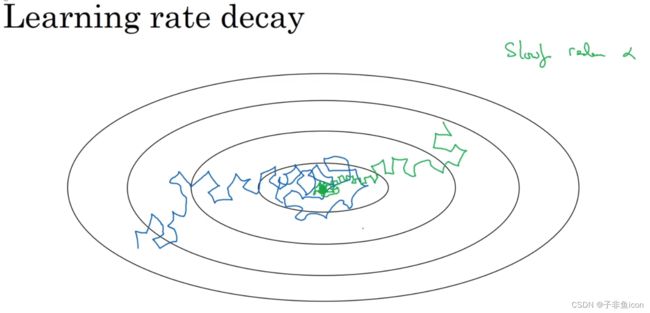
拆分成不同的mini-batch,第一次遍历训练集叫做第一代。

其他的一些衰减方式:
1. α = 0.9 5 e p o c h − n u m α 0 \alpha=0.95^{epoch-num}\alpha_{0} α=0.95epoch−numα0
2. α = k e p o c h − n u m α 0 \alpha=\frac{k}{\sqrt {epoch-num}} \alpha_{0} α=epoch−numkα0或者 α = k t α 0 \alpha=\frac{k}{\sqrt {t} }\alpha_{0} α=tkα0(t为mini-batch 的数字)
3.离散下降,一次减少一半。
七、局部最优的问题
通常梯度为0的点并不是图1中的局部最优点,实际上,成本函数的零梯度点,通常是鞍点。
即一个具有高维度空间的函数,如果梯度为0,在每个方向,它可能是凸函数,也可能是凹函数。因此吗,更可能碰到鞍点。
但平稳段是一个问题,这会使得学习十分缓慢,所以Mmomentum或者RMSprop、Adam才要加速学习算法。
八、编程作业
参考链接
opt_utils.py
import numpy as np
import matplotlib.pyplot as plt
import sklearn
import sklearn.datasets
def sigmoid(x):
"""
Compute the sigmoid of x
Arguments:
x -- A scalar or numpy array of any size.
Return:
s -- sigmoid(x)
"""
s = 1/(1+np.exp(-x))
return s
def relu(x):
"""
Compute the relu of x
Arguments:
x -- A scalar or numpy array of any size.
Return:
s -- relu(x)
"""
s = np.maximum(0,x)
return s
def load_params_and_grads(seed=1):
np.random.seed(seed)
W1 = np.random.randn(2,3)
b1 = np.random.randn(2,1)
W2 = np.random.randn(3,3)
b2 = np.random.randn(3,1)
dW1 = np.random.randn(2,3)
db1 = np.random.randn(2,1)
dW2 = np.random.randn(3,3)
db2 = np.random.randn(3,1)
return W1, b1, W2, b2, dW1, db1, dW2, db2
def initialize_parameters(layer_dims):
"""
Arguments:
layer_dims -- python array (list) containing the dimensions of each layer in our network
Returns:
parameters -- python dictionary containing your parameters "W1", "b1", ..., "WL", "bL":
W1 -- weight matrix of shape (layer_dims[l], layer_dims[l-1])
b1 -- bias vector of shape (layer_dims[l], 1)
Wl -- weight matrix of shape (layer_dims[l-1], layer_dims[l])
bl -- bias vector of shape (1, layer_dims[l])
Tips:
- For example: the layer_dims for the "Planar Data classification model" would have been [2,2,1].
This means W1's shape was (2,2), b1 was (1,2), W2 was (2,1) and b2 was (1,1). Now you have to generalize it!
- In the for loop, use parameters['W' + str(l)] to access Wl, where l is the iterative integer.
"""
np.random.seed(3)
parameters = {}
L = len(layer_dims) # number of layers in the network
for l in range(1, L):
parameters['W' + str(l)] = np.random.randn(layer_dims[l], layer_dims[l-1])* np.sqrt(2 / layer_dims[l-1])
parameters['b' + str(l)] = np.zeros((layer_dims[l], 1))
assert(parameters['W' + str(l)].shape == layer_dims[l], layer_dims[l-1])
assert(parameters['W' + str(l)].shape == layer_dims[l], 1)
return parameters
def forward_propagation(X, parameters):
"""
Implements the forward propagation (and computes the loss) presented in Figure 2.
Arguments:
X -- input dataset, of shape (input size, number of examples)
parameters -- python dictionary containing your parameters "W1", "b1", "W2", "b2", "W3", "b3":
W1 -- weight matrix of shape ()
b1 -- bias vector of shape ()
W2 -- weight matrix of shape ()
b2 -- bias vector of shape ()
W3 -- weight matrix of shape ()
b3 -- bias vector of shape ()
Returns:
loss -- the loss function (vanilla logistic loss)
"""
# retrieve parameters
W1 = parameters["W1"]
b1 = parameters["b1"]
W2 = parameters["W2"]
b2 = parameters["b2"]
W3 = parameters["W3"]
b3 = parameters["b3"]
# LINEAR -> RELU -> LINEAR -> RELU -> LINEAR -> SIGMOID
z1 = np.dot(W1, X) + b1
a1 = relu(z1)
z2 = np.dot(W2, a1) + b2
a2 = relu(z2)
z3 = np.dot(W3, a2) + b3
a3 = sigmoid(z3)
cache = (z1, a1, W1, b1, z2, a2, W2, b2, z3, a3, W3, b3)
return a3, cache
def backward_propagation(X, Y, cache):
"""
Implement the backward propagation presented in figure 2.
Arguments:
X -- input dataset, of shape (input size, number of examples)
Y -- true "label" vector (containing 0 if cat, 1 if non-cat)
cache -- cache output from forward_propagation()
Returns:
gradients -- A dictionary with the gradients with respect to each parameter, activation and pre-activation variables
"""
m = X.shape[1]
(z1, a1, W1, b1, z2, a2, W2, b2, z3, a3, W3, b3) = cache
dz3 = 1./m * (a3 - Y)
dW3 = np.dot(dz3, a2.T)
db3 = np.sum(dz3, axis=1, keepdims = True)
da2 = np.dot(W3.T, dz3)
dz2 = np.multiply(da2, np.int64(a2 > 0))
dW2 = np.dot(dz2, a1.T)
db2 = np.sum(dz2, axis=1, keepdims = True)
da1 = np.dot(W2.T, dz2)
dz1 = np.multiply(da1, np.int64(a1 > 0))
dW1 = np.dot(dz1, X.T)
db1 = np.sum(dz1, axis=1, keepdims = True)
gradients = {"dz3": dz3, "dW3": dW3, "db3": db3,
"da2": da2, "dz2": dz2, "dW2": dW2, "db2": db2,
"da1": da1, "dz1": dz1, "dW1": dW1, "db1": db1}
return gradients
def compute_cost(a3, Y):
"""
Implement the cost function
Arguments:
a3 -- post-activation, output of forward propagation
Y -- "true" labels vector, same shape as a3
Returns:
cost - value of the cost function
"""
m = Y.shape[1]
logprobs = np.multiply(-np.log(a3),Y) + np.multiply(-np.log(1 - a3), 1 - Y)
cost = 1./m * np.sum(logprobs)
return cost
def predict(X, y, parameters):
"""
This function is used to predict the results of a n-layer neural network.
Arguments:
X -- data set of examples you would like to label
parameters -- parameters of the trained model
Returns:
p -- predictions for the given dataset X
"""
m = X.shape[1]
p = np.zeros((1,m), dtype = np.int)
# Forward propagation
a3, caches = forward_propagation(X, parameters)
# convert probas to 0/1 predictions
for i in range(0, a3.shape[1]):
if a3[0,i] > 0.5:
p[0,i] = 1
else:
p[0,i] = 0
# print results
#print ("predictions: " + str(p[0,:]))
#print ("true labels: " + str(y[0,:]))
print("Accuracy: " + str(np.mean((p[0,:] == y[0,:]))))
return p
def predict_dec(parameters, X):
"""
Used for plotting decision boundary.
Arguments:
parameters -- python dictionary containing your parameters
X -- input data of size (m, K)
Returns
predictions -- vector of predictions of our model (red: 0 / blue: 1)
"""
# Predict using forward propagation and a classification threshold of 0.5
a3, cache = forward_propagation(X, parameters)
predictions = (a3 > 0.5)
return predictions
def plot_decision_boundary(model, X, y):
# Set min and max values and give it some padding
x_min, x_max = X[0, :].min() - 1, X[0, :].max() + 1
y_min, y_max = X[1, :].min() - 1, X[1, :].max() + 1
h = 0.01
# Generate a grid of points with distance h between them
xx, yy = np.meshgrid(np.arange(x_min, x_max, h), np.arange(y_min, y_max, h))
# Predict the function value for the whole grid
Z = model(np.c_[xx.ravel(), yy.ravel()])
Z = Z.reshape(xx.shape)
# Plot the contour and training examples
plt.contourf(xx, yy, Z, cmap=plt.cm.Spectral)
plt.ylabel('x2')
plt.xlabel('x1')
plt.scatter(X[0, :], X[1, :], c=y, cmap=plt.cm.Spectral)
plt.show()
def load_dataset(is_plot = True):
np.random.seed(3)
train_X, train_Y = sklearn.datasets.make_moons(n_samples=300, noise=.2) #300 #0.2
# Visualize the data
if is_plot:
plt.scatter(train_X[:, 0], train_X[:, 1], c=train_Y, s=40, cmap=plt.cm.Spectral)
plt.show()
train_X = train_X.T
train_Y = train_Y.reshape((1, train_Y.shape[0]))
return train_X, train_Y
实现代码:
import numpy as np
import matplotlib.pyplot as plt
import scipy.io
import math
import sklearn
import sklearn.datasets
import opt_utils
import testCase
plt.rcParams['figure.figsize'] = (7.0, 4.0) # set default size of plots
plt.rcParams['image.interpolation'] = 'nearest'
plt.rcParams['image.cmap'] = 'gray'
# 梯度下降
def update_parameters_with_gd(parameters, grads, learning_rate):
L = len(parameters) // 2
for l in range(L):
parameters["W" + str(l+1)] = parameters["W" + str(l+1)] - learning_rate * grads["dW" + str(l+1)]
parameters["b" + str(l+1)] = parameters["b" + str(l+1)] - learning_rate * grads["db" + str(l+1)]
return parameters
# 实现mini-batch
def random_mini_batches(X, Y, mini_batch_size=64, seed=0):
np.random.seed(seed)
m = X.shape[1]
mini_batches = []
# 先打乱顺序
permutation = list(np.random.permutation(m)) # #它会返回一个长度为m的随机数组,且里面的数是0到m-1;这里不用list也行
shuffle_X = X[:, permutation]
shuffle_Y = Y[:, permutation].reshape((1, m))
# 分割
num_complete_minibatches = math.floor(m / mini_batch_size) # 向下取整,一共分成了多少份
for k in range(0, num_complete_minibatches):
mini_batch_X = shuffle_X[:, k*mini_batch_size:(k+1) * mini_batch_size]
mini_batch_Y = shuffle_Y[:, k * mini_batch_size:(k + 1) * mini_batch_size]
mini_batch = (mini_batch_X, mini_batch_Y)
mini_batches.append(mini_batch)
# 处理没有被平分的剩余部分
if m % mini_batch_size != 0:
mini_batch_X = shuffle_X[:, num_complete_minibatches * mini_batch_size:]
mini_batch_Y = shuffle_Y[:, num_complete_minibatches * mini_batch_size:]
mini_batch = (mini_batch_X, mini_batch_Y)
mini_batches.append(mini_batch)
return mini_batches
# 初始化,包含动量的梯度下降,建立一个和dW、db相同结构的变量来影响他们
def initialize_velocity(parameters):
L = len(parameters) // 2
v = {}
for l in range(L):
v["dW" + str(l + 1)] = np.zeros_like(parameters["W" + str(l + 1)])
v["db" + str(l + 1)] = np.zeros_like(parameters["b" + str(l + 1)])
return v
# 实现动量梯度下降
def update_parameters_with_momentum(parameters, grads, v, beta, learning_rate):
L = len(parameters) // 2
for l in range(L):
v["dW" + str(l + 1)] = beta * v["dW" + str(l + 1)] + (1 - beta) * grads["dW" + str(l + 1)]
parameters["W" + str(l + 1)] = parameters["W" + str(l + 1)] - learning_rate * v["dW" + str(l + 1)]
v["db" + str(l + 1)] = beta * v["db" + str(l + 1)] + (1 - beta) * grads["db" + str(l + 1)]
parameters["b" + str(l + 1)] = parameters["b" + str(l + 1)] - learning_rate * v["db" + str(l + 1)]
return parameters, v
# 初始化,Adam算法
def initialize_adam(parameters):
L = len(parameters) // 2
v = {}
s = {}
for l in range(L):
v["dW" + str(l + 1)] = np.zeros_like(parameters["W" + str(l + 1)])
v["db" + str(l + 1)] = np.zeros_like(parameters["b" + str(l + 1)])
s["dW" + str(l + 1)] = np.zeros_like(parameters["W" + str(l + 1)])
s["db" + str(l + 1)] = np.zeros_like(parameters["b" + str(l + 1)])
return (v, s)
# 实现Adam算法
def update_parameters_with_adam(parameters, grads, v, s, t, learning_rate=0.1, beta1=0.9, beta2=0.999, epsilon=1e-8):
L = len(parameters) // 2
v_corrected = {}
s_corrected = {}
for l in range(L):
v["dW" + str(l + 1)] = beta1 * v["dW" + str(l + 1)] + (1 - beta1) * grads["dW" + str(l + 1)]
v_corrected["dW" + str(l + 1)] = v["dW" + str(l + 1)] / (1 - np.power(beta1, t))
s["dW" + str(l + 1)] = beta2 * s["dW" + str(l + 1)] + (1 - beta2) * np.square(grads["dW" + str(l + 1)])
s_corrected["dW" + str(l + 1)] = s["dW" + str(l + 1)] / (1 - np.power(beta2, t))
# parameters["W" + str(l + 1)] = parameters["W" + str(l + 1)] - learning_rate * v_corrected["dW" + str(l + 1)] / (np.sqrt(s_corrected["dW" + str(l + 1)]) + epsilon)
parameters["W" + str(l + 1)] = parameters["W" + str(l + 1)] - learning_rate * (v_corrected["dW" + str(l + 1)] /
np.sqrt(s_corrected["dW" + str(l + 1)] + epsilon)) # 将epsilon写在根号里面
v["db" + str(l + 1)] = beta1 * v["db" + str(l + 1)] + (1 - beta1) * grads["db" + str(l + 1)]
v_corrected["db" + str(l + 1)] = v["db" + str(l + 1)] / (1 - np.power(beta1, t))
s["db" + str(l + 1)] = beta2 * s["db" + str(l + 1)] + (1 - beta2) * np.square(grads["db" + str(l + 1)])
s_corrected["db" + str(l + 1)] = s["db" + str(l + 1)] / (1 - np.power(beta2, t))
# parameters["b" + str(l + 1)] = parameters["b" + str(l + 1)] - learning_rate * v_corrected["db" + str(l + 1)] / (np.sqrt(s_corrected["db" + str(l + 1)]) + epsilon)
parameters["b" + str(l + 1)] = parameters["b" + str(l + 1)] - learning_rate * (v_corrected["db" + str(l + 1)] /
np.sqrt(s_corrected["db" + str(l + 1)] + epsilon))
return (parameters, v, s)
# 测试
# 加载数据集
train_X, train_Y = opt_utils.load_dataset(is_plot=True)
# 定义模型
def model(X, Y, layers_dims, optimizer, learning_rate=0.0007, mini_batch_size=64, beta1=0.9, beta2=0.999, epsilon=1e-8, num_epochs=10000, print_cost=True, is_plot=True):
L = len(layers_dims)
costs = []
t = 0 # 每学习一个mini-batch,t就加一
seed = 10
parameters = opt_utils.initialize_parameters(layers_dims)
# 选择优化器
if optimizer == "gd":
pass
elif optimizer == "momentum":
v = initialize_velocity(parameters)
elif optimizer == "adam":
v, s = initialize_adam(parameters)
else:
print("optimizer参数错误,程序退出。")
exit(1)
for i in range(num_epochs):
seed = seed + 1 # 每次遍历完数据集后,重新排列数据集
minibatches = random_mini_batches(X, Y, mini_batch_size, seed)
for minibatch in minibatches:
(minibatch_X, minibatch_Y) = minibatch
A3, cache = opt_utils.forward_propagation(minibatch_X, parameters)
cost = opt_utils.compute_cost(A3, minibatch_Y)
grads = opt_utils.backward_propagation(minibatch_X, minibatch_Y, cache)
# 更新参数
if optimizer == "gd":
parameters = update_parameters_with_gd(parameters, grads, learning_rate)
elif optimizer == "momentum":
parameters, v = update_parameters_with_momentum(parameters, grads, v, beta1, learning_rate)
elif optimizer == "adam":
t = t + 1
parameters, v, s = update_parameters_with_adam(parameters, grads, v, s, t, learning_rate, beta1, beta2, epsilon)
if i % 100 == 0:
costs.append(cost)
if print_cost and i % 1000 == 0:
print("第" + str(i) + "次遍历整个数据集,当前误差值:" + str(cost))
if is_plot:
plt.plot(costs)
plt.ylabel('cost')
plt.xlabel('epochs (per 100)')
plt.title("Learning rate = " + str(learning_rate))
plt.show()
return parameters
layers_dims = [train_X.shape[0], 5, 2, 1]
# 使用普通的梯度下降
#parameters = model(train_X, train_Y, layers_dims, optimizer="gd",is_plot=True)
#使用动量的梯度下降
#parameters = model(train_X, train_Y, layers_dims, beta1=0.9, optimizer="momentum", is_plot=True)
#使用Adam优化的梯度下降
parameters = model(train_X, train_Y, layers_dims, optimizer="adam", is_plot=True)
#预测
preditions = opt_utils.predict(train_X,train_Y,parameters)
#绘制分类图
#plt.title("Model with Gradient Descent optimization")
axes = plt.gca()
axes.set_xlim([-1.5, 2.5])
axes.set_ylim([-1, 1.5])
opt_utils.plot_decision_boundary(lambda x: opt_utils.predict_dec(parameters, x.T), train_X, train_Y)
8.1. 使用普通的梯度下降
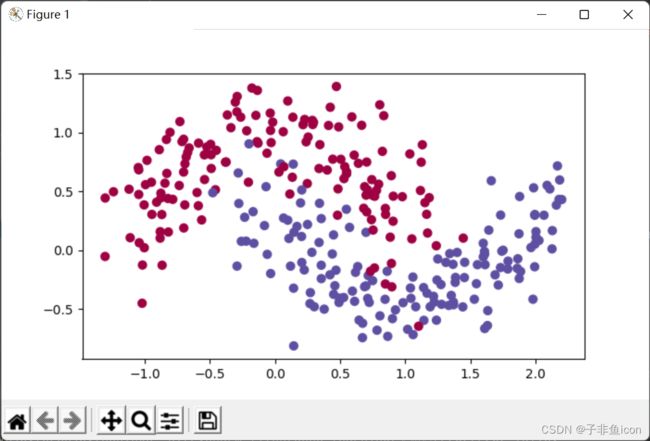
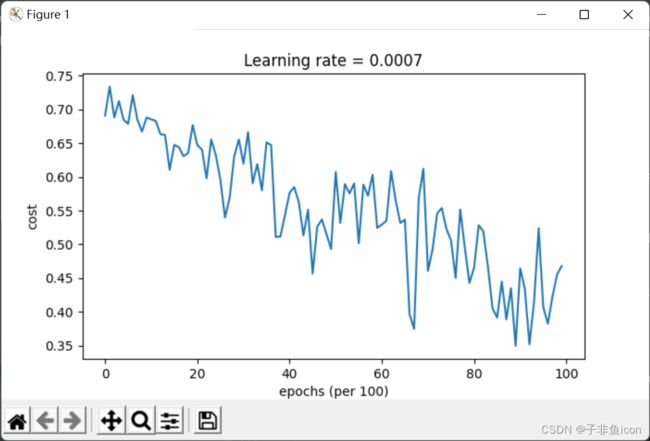
震荡原因:每个子训练集收敛的方向不一定和总训练集收敛方向相同(有时候甚至相反),所以会震荡。但是因为训练总是遍历了总训练集,所以虽然震荡但还是向cost小的方向收敛
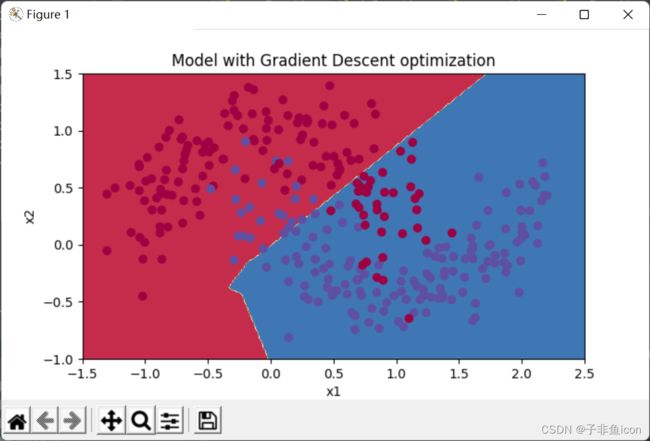
第0次遍历整个数据集,当前误差值:0.690735512291113
第1000次遍历整个数据集,当前误差值:0.6852725328458241
第2000次遍历整个数据集,当前误差值:0.6470722240719003
第3000次遍历整个数据集,当前误差值:0.6195245549970402
第4000次遍历整个数据集,当前误差值:0.5765844355950945
第5000次遍历整个数据集,当前误差值:0.6072426395968576
第6000次遍历整个数据集,当前误差值:0.5294033317684576
第7000次遍历整个数据集,当前误差值:0.46076823985930115
第8000次遍历整个数据集,当前误差值:0.465586082399045
第9000次遍历整个数据集,当前误差值:0.4645179722167684
Accuracy: 0.7966666666666666
第0次遍历整个数据集,当前误差值:0.6907412988351506
第1000次遍历整个数据集,当前误差值:0.6853405261267578
第2000次遍历整个数据集,当前误差值:0.6471448370095255
第3000次遍历整个数据集,当前误差值:0.6195943032076022
第4000次遍历整个数据集,当前误差值:0.5766650344073023
第5000次遍历整个数据集,当前误差值:0.607323821900647
第6000次遍历整个数据集,当前误差值:0.5294761758786997
第7000次遍历整个数据集,当前误差值:0.46093619004872366
第8000次遍历整个数据集,当前误差值:0.465780093701272
第9000次遍历整个数据集,当前误差值:0.4647395967922748
Accuracy: 0.7966666666666666
因为这个例子比较简单,使用动量效果很小,但对于更复杂的问题,会有更好的效果。
8.3. 使用Adam的梯度下降
第0次遍历整个数据集,当前误差值:0.6905522446113365
第1000次遍历整个数据集,当前误差值:0.18550136438550574
第2000次遍历整个数据集,当前误差值:0.15083046575253212
第3000次遍历整个数据集,当前误差值:0.07445438570997179
第4000次遍历整个数据集,当前误差值:0.1259591565133716
第5000次遍历整个数据集,当前误差值:0.10434443534245479
第6000次遍历整个数据集,当前误差值:0.10067637504120656
第7000次遍历整个数据集,当前误差值:0.0316520301351156
第8000次遍历整个数据集,当前误差值:0.11197273131244208
第9000次遍历整个数据集,当前误差值:0.19794007152465498
Accuracy: 0.94
具有动量的梯度下降通常可以有很好的效果,但由于小的学习速率和简单的数据集所以它的影响几乎是轻微的。另一方面,Adam明显优于小批量梯度下降和具有动量的梯度下降,如果在这个简单的模型上运行更多时间的数据集,这三种方法都会产生非常好的结果,然而,我们已经看到Adam收敛得更快。
np.random.permutation()函数



